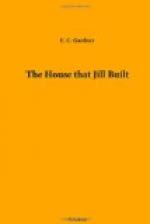[Illustration: A GARGOYLE]
“How perfectly delightful!” exclaimed Bessie. “Those horribly grotesque old gargoyles are just glorious. Don’t you delight in the antique, Mr. James, when it isn’t too horrible?”
“Yes, they are awfully jolly. We had a great time with them last ‘Fourth.’ I got myself up as a pirate king—black flag, skull and cross-bones, you know. It was awfully jolly.”
“I never saw any of that kind, but you will have some gargoyles, won’t you, Jill?”
“Possibly, for the architect says’ whether you have gutters entirely around the house or not; it will doubtless be necessary to catch the water that would fall upon the steps or balconies in short eave-troughs, and as they are certain to be conspicuous they should be respectfully treated. As they add to the comfort of the house they should also add to its beauty.’ Now what shall be said on this subject? His opinion appears to be that if we do not need to save the water for use, and if it will do no harm upon the ground around the house, it will be best to omit them except where protection is needed for something below. He sends some sketches and says ’they represent a few of the methods by which the water may be caught and carried to the ground. Number two and number three will prevent the sliding of the snow from the roof, which is sometimes desirable, but not always. Gutters made in this form should be so near the eaves that in case of accidental injury the water could not find its way inside the main walls. Number five has the advantage of leaving the house uninjured whatever happens to the gutter itself. It may leak through its entire length or run over on both sides without doing other harm than wasting the water.’ I don’t see,” said Jill, laying down the letter, “how we can give instructions without dictating in matters of ’construction and design,’ concerning which the architect distinctly objects to advice.”
[Illustration: A CHOICE OF GUTTERS.]
“Tell him we don’t care what becomes of the water and the lawn will take care of itself. Then ‘instruct’ him to exercise his own discretion. That’s what he is for. What next?”
“He would like to know our wishes in regard to fireplaces.”
“I thought the heating question had been decided once according to Uncle Harry’s doctrines.”




